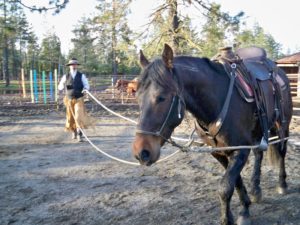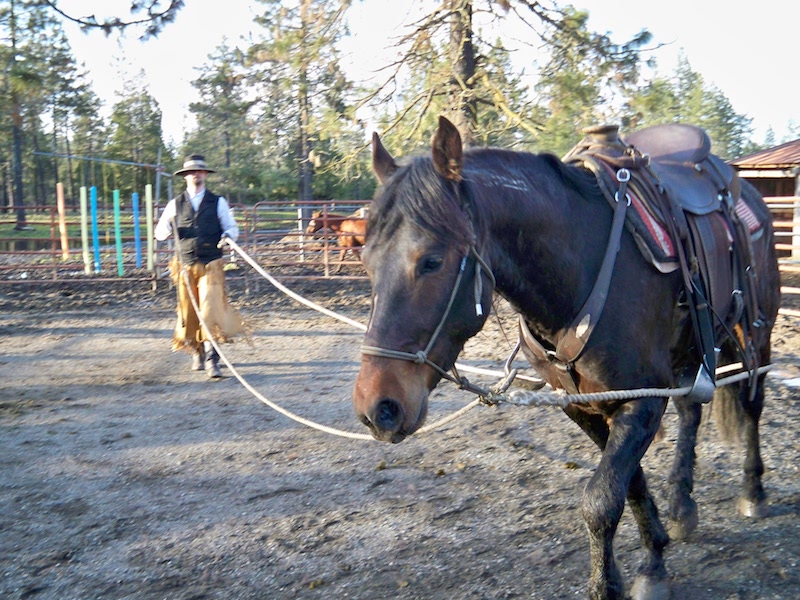by Brent Rollins

If you have been keeping up with my last two articles, your horse is now plenty desensitized and has become much braver. Your next step is the first saddling and ground driving. These are the tools you will need to be successful: a rope halter, two cotton long lines 25 feet long, a surcingle or lightweight saddle.
Begin by putting a halter and long line on your mustang in a round pen. Use a cotton long line, don’t use a nylon lunge line as it will hurt your hands and could burn your horse if he was to get tangled in it. There are a couple of options for saddling. I highly suggest a surcingle before the saddle because it is not the saddle that bothers the horse, it is the pressure. The surcingle is smaller and lighter and easier to use if your horse becomes upset and bucks or spooks. It is much better than lugging around your saddle. If you don’t have a surcingle, use a saddle that you won’t mind scuffing up. A lightweight saddle is best so your arms don’t get tired from carrying it around and putting it on and off.
After you choose your equipment, throw your saddle/surcingle on and off until your horse accepts it and stands calmly. When you cinch up, do it quickly and calmly so if your mustang were to buck or bolt the gear won’t fall or slip under the horse’s belly. I have had some mustangs jump and take off every time I tried to cinch up, for these I suggest hobbling just so you can get everything hooked up without an issue. Once your saddle/surcingle is cinched up, try having your mustang walk with you, don’t just send him off at a trot. We are trying to keep him from bucking, not encouraging it.
Walk around the round pen with him giving him lots of praise and encouragement. Now send him off at a trot on the long line. If he bucks while you are sending him, pull his head towards you and disengage the hindquarters. Be sure to voice your disapproval of this behavior. Once you get him stopped, ask him to trot again. Keep this up until he accepts the saddle and no longer bucks or crow hops.
For ground driving you will need two 25 foot cotton long lines. You should already have one long line on your horse. Take the other one and run it through the left or right stirrup snap first. Coil the rope and put it over the horn. Take the other rope, unsnap it from the halter and run it through the opposite stirrup and back to the halter. The long lines should be on opposite sides, running through each stirrup and attached to the halter with one side coiled over the horn. Stand to one side and gather the long lines, flipping the off side line down the back until it falls behind the horse’s rump. Pick up both ropes like you were in a wagon and shake them to create energy to get your mustang moving.
Your mustang may not like the rope against his hocks and may kick, try to push through this behavior. If the rope gets pulled from your hands, either try to pick it up or stop the horse, pick it up and start again. Some horses take to ground driving easily while others don’t. Avoid becoming frustrated; keep working at it until it becomes easier. Only work one rope at a time to change directions. Just like when riding, don’t pull on both reins unless to stop or back up. When you change directions it helps to step across toward your horse’s shoulder and pull on the outside “rein” or rope. Once he changes, flip the other rope against his hocks to get energy.
Ground driving takes practice, but it is a safe way to help your mustang understand what to expect when you ride him. Keep this up until the horse accepts it comfortably. When you accomplish ground driving, you will be ready for the next step which is your first ride. If at any point you feel your mustang needs a refresher, you can always go back to ground work. Next month I will cover the first ride in the online edition of the magazine.
Published April 2014 Issue
Brent Rollins is one of the industry’s leading experts on mustangs. He has been called the “mustang whisperer” by Craig Cameron. Brent is an EXCA cowboy race judge, and Craig Cameron certified Trainer. Brent travels Oregon, Washington and California giving clinics and expos, promoting the mustang and their versatility. He educates adopters and potential adopters on what to expect with their new mustang and deals with misconceptions regarding mustangs and domestic horses. He also helps with problem horses. Brent believes that every horse deserves a chance to be great. For more information about Brent and his program visit www.brhorsemanship.com.






